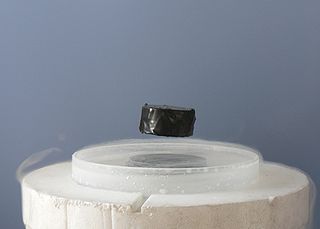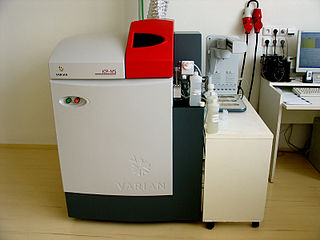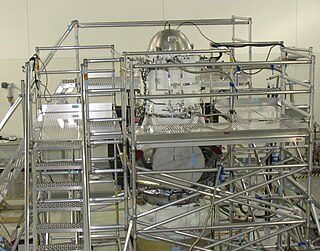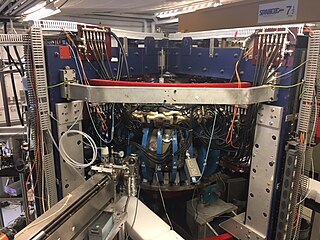Related Research Articles

In physics, cryogenics is the production and behaviour of materials at very low temperatures.

Helium is a chemical element with the symbol He and atomic number 2. It is a colorless, odorless, tasteless, non-toxic, inert, monatomic gas and the first in the noble gas group in the periodic table. Its boiling and melting point are the lowest among all the elements. It is the second lightest and second most abundant element in the observable universe, after hydrogen. It is present at about 24% of the total elemental mass, which is more than 12 times the mass of all the heavier elements combined. Its abundance is similar to this in both the Sun and in Jupiter, due to the very high nuclear binding energy of helium-4, with respect to the next three elements after helium. This helium-4 binding energy also accounts for why it is a product of both nuclear fusion and radioactive decay. The most common isotope of helium in the universe is helium-4, the vast majority of which was formed during the Big Bang. Large amounts of new helium are created by nuclear fusion of hydrogen in stars.

Superconductivity is a set of physical properties observed in certain materials where electrical resistance vanishes and magnetic flux fields are expelled from the material. Any material exhibiting these properties is a superconductor. Unlike an ordinary metallic conductor, whose resistance decreases gradually as its temperature is lowered, even down to near absolute zero, a superconductor has a characteristic critical temperature below which the resistance drops abruptly to zero. An electric current through a loop of superconducting wire can persist indefinitely with no power source.

Inductively coupled plasma mass spectrometry (ICP-MS) is a type of mass spectrometry that uses an inductively coupled plasma to ionize the sample. It atomizes the sample and creates atomic and small polyatomic ions, which are then detected. It is known and used for its ability to detect metals and several non-metals in liquid samples at very low concentrations. It can detect different isotopes of the same element, which makes it a versatile tool in isotopic labeling.
Some of the technological applications of superconductivity include:

A magnetometer is a device that measures magnetic field or magnetic dipole moment. Different types of magnetometers measure the direction, strength, or relative change of a magnetic field at a particular location. A compass is one such device, one that measures the direction of an ambient magnetic field, in this case, the Earth's magnetic field. Other magnetometers measure the magnetic dipole moment of a magnetic material such as a ferromagnet, for example by recording the effect of this magnetic dipole on the induced current in a coil.

Magnetic refrigeration is a cooling technology based on the magnetocaloric effect. This technique can be used to attain extremely low temperatures, as well as the ranges used in common refrigerators.

Liquid helium is a physical state of helium at very low temperatures at standard atmospheric pressures. Liquid helium may show superfluidity.

A 3He/4He dilution refrigerator is a cryogenic device that provides continuous cooling to temperatures as low as 2 mK, with no moving parts in the low-temperature region. The cooling power is provided by the heat of mixing of the helium-3 and helium-4 isotopes.

A superconducting magnet is an electromagnet made from coils of superconducting wire. They must be cooled to cryogenic temperatures during operation. In its superconducting state the wire has no electrical resistance and therefore can conduct much larger electric currents than ordinary wire, creating intense magnetic fields. Superconducting magnets can produce stronger magnetic fields than all but the strongest non-superconducting electromagnets, and large superconducting magnets can be cheaper to operate because no energy is dissipated as heat in the windings. They are used in MRI instruments in hospitals, and in scientific equipment such as NMR spectrometers, mass spectrometers, fusion reactors and particle accelerators. They are also used for levitation, guidance and propulsion in a magnetic levitation (maglev) railway system being constructed in Japan.

A cryostat is a device used to maintain low cryogenic temperatures of samples or devices mounted within the cryostat. Low temperatures may be maintained within a cryostat by using various refrigeration methods, most commonly using cryogenic fluid bath such as liquid helium. Hence it is usually assembled into a vessel, similar in construction to a vacuum flask or Dewar. Cryostats have numerous applications within science, engineering, and medicine.

Gas blending for scuba diving is the filling of diving cylinders with non-air breathing gases such as nitrox, trimix and heliox. Use of these gases is generally intended to improve overall safety of the planned dive, by reducing the risk of decompression sickness and/or nitrogen narcosis, and may improve ease of breathing.
Niobium–titanium (Nb-Ti) is an alloy of niobium and titanium, used industrially as a type II superconductor wire for superconducting magnets, normally as Nb-Ti fibres in an aluminium or copper matrix.
The sorption pump is a vacuum pump that creates a vacuum by adsorbing molecules on a very porous material like molecular sieve which is cooled by a cryogen, typically liquid nitrogen. The ultimate pressure is about 10−2 mbar. With special techniques this can be lowered till 10−7 mbar. The main advantages are the absence of oil or other contaminants, low cost and vibration free operation because there are no moving parts. The main disadvantages are that it cannot operate continuously and cannot effectively pump hydrogen, helium and neon, all gases with lower condensation temperature than liquid nitrogen. The main application is as a roughing pump for a sputter-ion pump in ultra-high vacuum experiments, for example in surface physics.
A lambda point refrigerator is a device used to cool liquid helium, typically around a superconducting magnet or for low temperature measurements, from approximately 4.2 K to temperatures near the lambda point of helium, the temperature at which normal fluid helium transitions to the superfluid helium II. Cooling is achieved by pumping the liquid helium in the bath through a cooling coil via a needle valve and vacuum pump. The reduced pressure in the coil causes some of the helium to evaporate, creating a two-phase system within the cooling coil. The heat removed via evaporation lowers the temperature of the cooling coil closer to the lambda point. Since the cooling coil is immersed in the liquid helium bath, liquid surrounding the coil is also cooled. The colder, higher density liquid sinks away from the coil toward the bottom of the bath while the warmer, lower density liquid helium rises to the top. Liquid helium typically has poor thermal conductivity, so convective currents associated with a temperature gradient in the bath provide a constant flow of this colder liquid helium toward the bottom of the bath, allowing temperatures below 4.2 K to be realized in the helium bath, typically close to 2.2 K.

The pulse tube refrigerator (PTR) or pulse tube cryocooler is a developing technology that emerged largely in the early 1980s with a series of other innovations in the broader field of thermoacoustics. In contrast with other cryocoolers, this cryocooler can be made without moving parts in the low temperature part of the device, making the cooler suitable for a wide variety of applications.

Superconducting radio frequency (SRF) science and technology involves the application of electrical superconductors to radio frequency devices. The ultra-low electrical resistivity of a superconducting material allows an RF resonator to obtain an extremely high quality factor, Q. For example, it is commonplace for a 1.3 GHz niobium SRF resonant cavity at 1.8 kelvins to obtain a quality factor of Q=5×1010. Such a very high Q resonator stores energy with very low loss and narrow bandwidth. These properties can be exploited for a variety of applications, including the construction of high-performance particle accelerator structures.
Cryogenic seals provide a mechanical containment mechanism for materials held at cryogenic temperatures, such as cryogenic fluids. Various techniques, including soldering and welding are available for creating seals; however, specialized materials and processes are necessary to hermetically entrap cryogenic constituents under vacuum-tight conditions. Most commonly used are liquid helium and liquid nitrogen, which boil at very low temperatures, below −153 °C, as well as hydrocarbons with low freezing points and refrigerating mixtures. Pure indium wire or solder preform washers are accepted as the most reliable low temperature sealing materials. When correctly formed, indium will afford leak rates of less than 4.0x10 -9 mbar- liter/sec. Alternative cryogenic seal materials include silicone grease conical seals, and Pb/Sn (lead-tin) wire seals.

The Hybrid Illinois Device for Research and Applications (HIDRA) is a medium-sized toroidal magnetic fusion device housed in the Nuclear Radiation Laboratory and operated by the Center for Plasma-Material Interactions (CPMI) within the Department of Nuclear, Plasma and Radiological Engineering at the University of Illinois at Urbana–Champaign, United States. HIDRA had its first plasma at the end of April 2016 and started experimental campaigns by December of that year. HIDRA is the former WEGA classical stellarator that was operated at the Max Planck Institute for Plasma Physics in Greifswald Germany from 2001 to 2013.
Hydrogen cryomagnetics is a term used to denote the use of cryogenic liquid hydrogen to cool the windings of an electromagnet. A key benefit of hydrogen cryomagnetics is that low temperature liquid hydrogen can be deployed simultaneously both as a cryogen to cool electromagnet windings and as an energy carrier. That is, powerful synergistic benefits are likely to arise when hydrogen is used as a fuel and as a coolant. Even without the fuel/coolant synergies, hydrogen cryomagnetics is an attractive option for the cooling of superconducting electromagnets as it eliminates dependence upon increasingly scarce and expensive liquid helium. For hydrogen cryomagnetic applications specialist hydrogen-cooled electromagnets are wound using either copper or superconductors. Liquid-hydrogen-cooled copper-wound magnets work well as pulsed field magnets. Superconductors have the property that they can operate continuously and very efficiently as electrical resistive losses are almost entirely avoided. Most commonly the term "hydrogen cryomagnetics" is used to denote the use of cryogenic liquid hydrogen directly, or indirectly, to enable high temperature superconductivity in electromagnet windings.
References
- ↑ "HelioxVT - Nanoscience". Oxford Instruments. Retrieved 2023-02-02.
- ↑ "Heliox_brocure_Feb2019.pdf" (PDF). February 2019. Retrieved Feb 2, 2023.